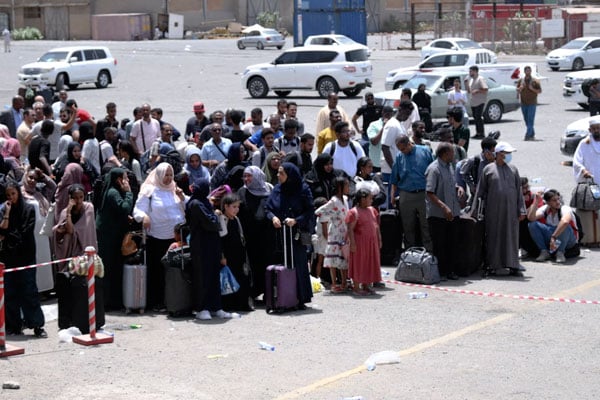Sudan conflict: Refugees on the move

People fleeing war-torn Sudan queue to board a boat from Port Sudan on April 28, 2023.PHOTO/ AFP
What you need to know:
- "There are huge numbers of people moving inside the country but also moving towards the borders," he added, noting the numbers "will be in the hundreds of thousands."
The fighting in Sudan has prompted a wave of people to seek sanctuary in neighbouring countries.
The picture is "very chaotic", UNHCR refugee agency spokesman Matt Saltmarsh told AFP on Friday.
"There are huge numbers of people moving inside the country but also moving towards the borders," he added, noting the numbers "will be in the hundreds of thousands."
Here is an overview of the situation:
Refugees, IDPs within Sudan
Sudan hosted 1.13 million refugees before the conflict started -- one of the largest refugee populations in Africa.
Of those, 800,000 are South Sudanese, with Eritreans the second-largest group, numbering 126,000. There are also 58,000 Ethiopians, mainly hosted in two eastern camps.
Axel Bisschop, the UNHCR's representative in Sudan, said Friday that up to 30,000 people, mainly South Sudanese refugees, had moved south from Khartoum to White Nile State, closer to their own border.
Ethiopian and Eritrean refugees are also moving closer to their own borders, he added.
Sudan counts around 3.7 million internally displaced persons, mostly in the volatile western Darfur region.
The UN's International Organization for Migration (IOM) said Tuesday that "at least 75,000 people have been internally displaced in Sudan by the crisis".
It said that in the South Darfur region, up to 37,000 people are thought to have been displaced across Nyala town.
Fleeing abroad
Sudan shares a border, in order of length, with South Sudan, Chad, Egypt, Ethiopia, Eritrea, Libya and the Central African Republic.
UNHCR is planning for three scenarios: Sudanese refugees fleeing to neighbouring countries; refugees hosted by Sudan returning home and refugees hosted by Sudan moving to other neighbouring countries.
"So far, the most significant cross-border movements in the region have been Sudanese fleeing to Chad and South Sudanese refugees returning to South Sudan," the agency said.
Chad
Saltmarsh, from UNHCR, said at least 20,000 people had crossed into Chad, of which around 5,000 have been formally registered so far.
The aid agency CARE International cited border area community leaders as saying more than 42,000 people had crossed.
UNHCR is expecting the number to rise to up to 100,000 people "in the worst case scenario".
Many had fled to villages only five kilometres (three miles) from Sudan, "and more are expected to arrive in the coming days," the agency said.
The IOM's Chad mission chief Anne Kathrin Schaefer said: "The majority of those arriving are in dire need of basic humanitarian aid, namely food, water and adequate shelter."
The looming rainy season will make it harder to reach the border area with aid.
More than 400,000 Sudanese refugees are already hosted across 13 camps and among local communities in eastern Chad.
Egypt
More than 14,000 Sudanese refugees have crossed the border, the Egyptian foreign ministry said Thursday, plus a further 2,000 nationals of 50 other countries.
Refugees making it to Cairo reported leaving with few belongings, food, water or cash on the treacherous journeys, having paid small fortunes for scarce bus tickets out of the war zone amid crippling fuel shortages.
UNHCR said it was working with the four-million-strong Sudanese community in Egypt to get a better sense of the new arrivals and to identify support needs.
South Sudan
Saltmarsh said Friday that 10,000 people had crossed the border.
That marks a significant increase since Tuesday, when UNHCR said nearly 4,000 South Sudanese refugees have crossed back into their country, mostly through the Renk crossing point.
Marie-Helene Verney, UNHCR's representative in South Sudan, said Tuesday "the most likely scenario is 125,000 returns of South Sudanese refugees into South Sudan, and 45,000 refugees."
Ethiopia
More than 3,500 people arrived in Ethiopia between April 21 and 25, Eric Mazango, the IOM's spokesman in the country, told AFP on Thursday.
Citizens of more than 35 countries have entered Ethiopia, with Turkish nationals accounting for more than 40 percent, followed by Ethiopians at 14 percent.
Central African Republic
On Monday, UN peacekeepers said a group of 500 mostly women and children had crossed the border, with local authorities saying they needed food, water and shelter. On Tuesday, the International Medical Corps said the number had reached 700, said UNHCR.
Libya and Eritrea
The Libyan authorities have noted no significant increase of entries from Sudan. UNHCR had no information on movement into Eritrea.





